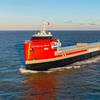Emirates Global Aluminium, the largest industrial company outside oil and gas, has signed a long-term port facility agreement with Abu Dhabi Ports to use some of the world’s largest bulk cargo vessels to import raw materials through Khalifa Port.
With this agreement, Abu Dhabi Ports will be able to develop the port to become the first in the Gulf capable of directly handling these massive ships.
Abu Dhabi Ports will fund and complete dredging and widening works to the Khalifa Port approach channel and basin including EGA’s berth. The dredging will deepen the channel to 18.5 metres and basin to 18.0 metres basis zero tide.
EGA plans to use large dry bulk ships to import raw materials without the need to transfer all or some of the cargo to smaller vessels outside the port, reducing long-term shipping costs and improving environmental performance.
The agreement was signed at EGA’s head-quarters in Al Taweelah (KIZAD) by Captain Mohamed Juma Al Shamisi, Chief Executive Officer of Abu Dhabi Ports and Abdulla Kalban, Managing Director and Chief Executive Officer of EGA.
In alignment with Abu Dhabi Port’s strategy the partnership between the two entities supports regional development by enhancing value to customers. The company has played a pioneering role by introducing other first-time ventures in the Middle East, including making Khalifa Port the region’s first semi-automated terminal, and developing Maqta Gateway, the first Emirati Port Community System (PCS).
The development at Khalifa Port is expected to lead to larger ships calling in to Abu Dhabi, creating new trade opportunities, supporting local industries and boosting the Emirate’s position as a global maritime trade hub.
EGA will use Capsize vessels to ship bauxite ore, the feedstock for alumina refineries, from the Republic of Guinea in West Africa. Currently, EGA is constructing UAE’s first alumina refinery next to its aluminium smelter in Khalifa Industrial Zone Abu Dhabi, located adjacent to Khalifa Port, ensuring streamlined logistics. Upon achieving full-production, the Al Taweelah alumina refinery will process five million tonnes of bauxite per annum.
Captain Al Shamisi said: “Today’s announcement marks another first for Abu Dhabi’s maritime and trade industry, and demonstrates our commitment to ongoing innovation and expansion in response to market and customer demands. As vital trade, logistics and industrial hubs of Abu Dhabi, Khalifa Port and KIZAD play a vital role in the Emirate’s economic diversification strategy. Khalifa Port will be the first port in the region with capsize vessel handling capacity, and with EGA’s long term commitment, will give an important boost to trade and investment in KIZAD and more broadly in the region.”
Abdulla Kalban said: “Dredging Khalifa Port to allow fully-laden Capesize vessels to reach EGA’s berth will reduce our costs, simplify our bauxite supply chain, and improve our environmental performance. I am also pleased that the enhanced capabilities at Khalifa Port will enable broader trade and economic benefits for Abu Dhabi.”
Khalifa Port is located halfway between Abu Dhabi and Dubai and is one of the most efficient and technologically advanced in the world, currently serving more than 20 shipping lines. KIZAD, the region’s largest industrial zone, covers 410 square kilometres around Khalifa Port.
EGA’s site is the biggest industrial facility at KIZAD and covers an area five times the size of Al Marayah Island in Abu Dhabi. EGA also operates an aluminium smelter at Jebel Ali in Dubai. Al Taweelah alumina refinery will produce 2 million tonnes of alumina per year, meeting 40 per cent of EGA’s requirements for feedstock for aluminium smelters.
Capesize vessels are amongst the largest dry bulk cargo ships. They are named Capesize because they are too large to transit the Suez and Panama Canals and must round the southernmost point of mainland Africa (Cape Aughulus) to transit between the Atlantic and Indian Oceans and the southernmost point of mainland South America (Cape Horn) to transit between the Atlantic and Pacific Oceans.










